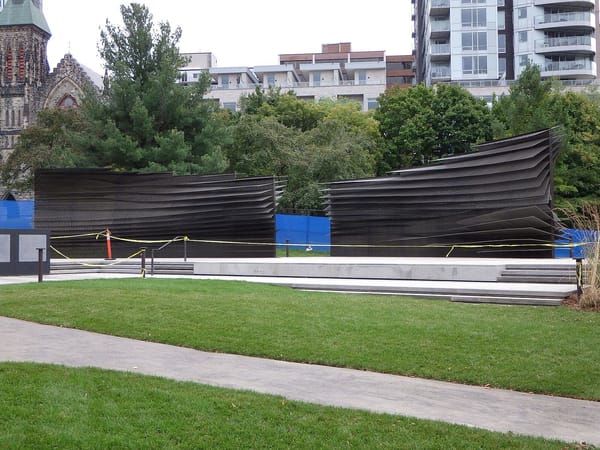The vandalism of a cenotaph in a Ukrainian cemetery in Oakville, Ont. dedicated to Waffen-SS veterans became international news on July 17 after Ottawa Citizen’s David Pugliese reported police were investigating the anti-Nazi graffiti as a “hate-motivated offense.”
Many around the world were shocked to learn of the memorial’s existence, yet this cenotaph isn’t even the oldest memorial at that cemetery glorifying Nazi collaborators. Canada is likely the only country in North America, if not the western hemisphere, with monuments dedicated to Waffen-SS veterans. There are also arguably more problematic Ukrainian memorials in Canada that have received little attention in the press.
Just a week after Pugliese’s troubling article, Progress Alberta reported that the Edmonton Police’s hate crimes unit is investigating the December 2019 vandalism of a larger-than-life bust that had been graffitied with the words “Nazi Scum.” (Yesterday, the Canadian Jewish Record reported that police “dismissed hate as a motivating factor in the vandalism.”)
The bust was of Roman Shukhevych, the commander of the Ukrainian Insurgent Army (UPA). There are at least a few memorials in Canada honouring the UPA, which had more Holocaust perpetrators in its midst than the Ukrainian Waffen-SS. The UPA, however, also had a more complicated relationship with the Nazis, and is a more politically sensitive subject today as it was created by the Organization of Ukrainian Nationalists-Bandera (OUN-B), which is alive and well in Canada, unlike the Waffen-SS veterans.
The Organization of Ukrainian Nationalists (OUN), founded in 1929, grew increasingly pro-Nazi during the 1930s. It split into two factions in 1940, with the more radical, youthful wing (OUN-B) led by Stepan Bandera. The OUN-B hoped to make Bandera the fascist dictator of an independent, ethnically cleansed Ukraine allied to Nazi Germany. Adolf Hitler had other plans, but the “Banderites” continued to collaborate with the Germans even after their leader wound up in a concentration camp.
The OUN-B created the UPA after the German army surrendered at Stalingrad, the turning point of the Second World War. Although ostensibly anti-Nazi, the UPA reconciled with the Germans in 1944, most of its wartime leadership were Nazi collaborators and many of its earliest recruits previously volunteered to join auxiliary police units that perpetrated the “Holocaust by Bullets” in western Ukraine.
In 1941, Shukhevych was tapped as the de facto Ukrainian leader of a German military intelligence formation, the Nachtigall Battalion, and the deputy commander of its successor, Schutzmannschaft (Auxiliary Police) Battalion 201. In 1943, Shukhevych became the UPA commander and the OUN-B leader in Ukraine, positions he held until his death in 1950.
All of the above groups murdered Jews. Shukhevych’s UPA massacred several thousand Jews and tens of thousands of Poles. This is who the statue in Edmonton is commemorating. But it gets worse.
In 1972, construction began on the large Roman Shukhevych Ukrainian Youth Unity Complex (UYUC) in Edmonton, including its bust of Shukhevych at the entrance. According to historian Per Rudling, the Albertan government footed 10 per cent of the approximately $750,000 in construction costs. In 2015, the federal government awarded a $279,138 grant to “repair” the aging OUN-B affiliated youth centre.
So for decades, Canada has underwritten the cultish worship of Ukrainian Nazi collaborator war criminals like Shukhevych.
Shortly after Pugliese’s article was published, Halton Regional Police announced that the graffitiing of the Waffen-SS cenotaph would no longer be investigated as a hate crime.
In a press release, Halton police tried to explain: “The initial information collected by investigators indicated that the graffiti may have been hate-motivated, targeting the identifiable group of Ukranians in general, or Ukrainian members of this cultural centre.” This begs the question: How did police in Ontario and Alberta come to identify Nazi collaborator memorials as somehow representing all Ukrainians?
During the Cold War, western governments looked the other way as far-right post-Second World War émigrés from western Ukraine — home of the OUN, UPA and the Ukrainian Waffen-SS division — began to take control of much of the organized Ukrainian diaspora. This was perhaps especially the case in Canada, where the OUN’s presence predated the war, and Ukrainians once comprised much of the Canadian Communist Party’s membership.
Canada banned the Communist Party and the pro-Soviet Ukrainian Labour Farmer Temple Association in 1940, and months later the government sponsored the creation of what was later renamed the Ukrainian Canadian Congress (UCC). A now-defunct pro-Nazi monarchist group and the OUN-affiliated Ukrainian National Federation were among the founding member organizations of the UCC, which has always enjoyed Ottawa’s recognition as the spokesbody of Ukrainian Canadians.
Today, the international coordinating body of OUN-B affiliated NGOs is called the International Council in Support of Ukraine (ICSU). The ICSU is the parent body for the Canadian Council in Support of Ukraine (CCSU), a coalition of Canadian Banderite organizations. It’s spearheaded by the League of Ukrainian Canadians (LUC), which plays a major role in the UCC and the Ukrainian World Congress (UWC). All of these organizations are presently headquartered in Toronto.
Moreover, the Ukrainian Youth Association (CYM), also founded in 1946, is itself an international organization affiliated with the OUN-B, and teaches young people that being a patriotic Ukrainian means glorifying the OUN-UPA. CYM has partially done so in Canada via ceremonies held in front of memorials and portraits, and Edmonton’s bust of Shukhevych in particular. Outside of Ukraine, only in Canada is CYM so brazen about displaying portraits of its fascist heroes.
Since the vandalism of the Oakville cenotaph, leaders of the UCC and LUC have drafted statements defending the Waffen-SS memorial. The LUC leadership has called the “Nazi War Monument” graffiti a “hate crime,” declaring, “These attacks are designed to destabilize Canadians’ national unity and undercut our government’s opposition to Putin’s Russia and support for Ukraine…”
As such, in both cases of police investigations into the statue vandalism, it was presumably these sort of nationalist Ukrainian Canadians that led officers astray by decrying the incidents as hate crimes, thereby essentially smearing all Ukrainians in Canada.
The Waffen-SS cenotaph in Oakville is a relic of a mostly unknown chapter of Canadian history that needs further excavation. But so too do the Banderites, who are still active in Canada, propagandizing young people and exerting significant political influence acting as the spokespeople of all Ukrainians.






